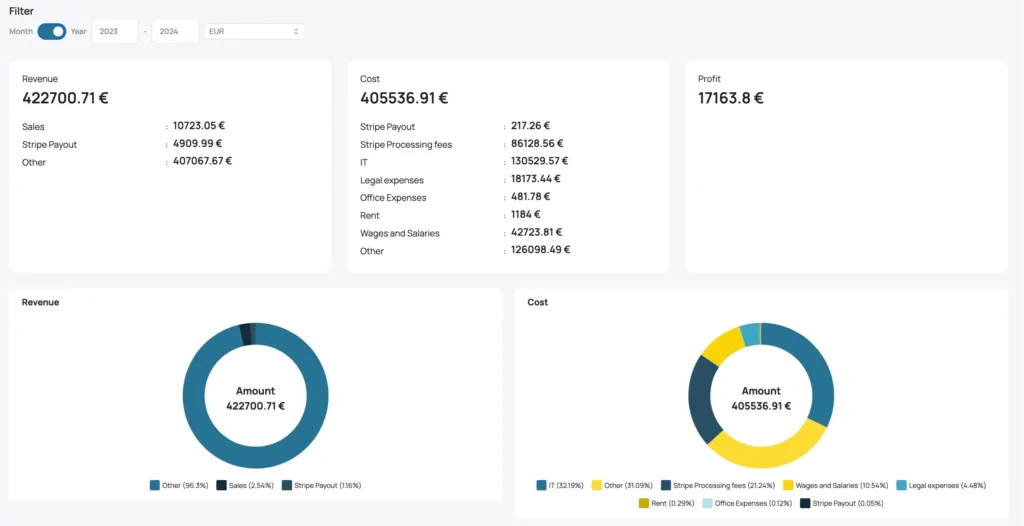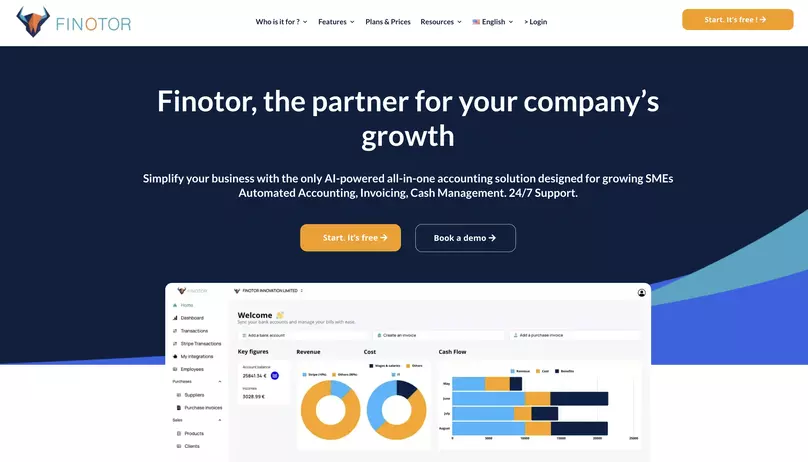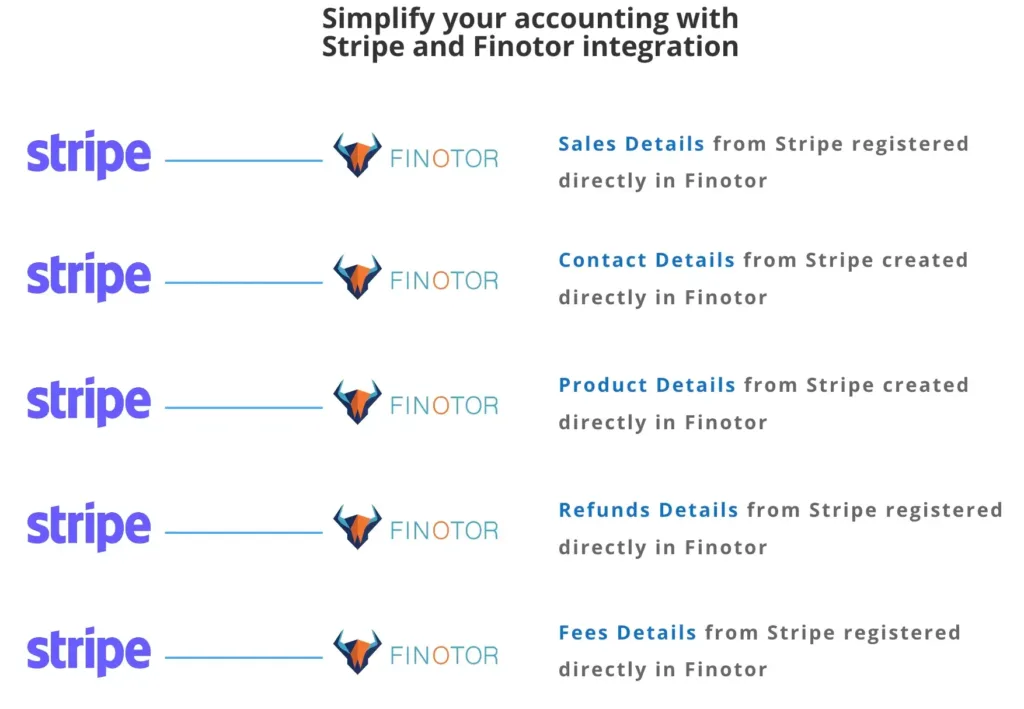Contents
- 1 1- Understanding the Basics of Financial Statements
- 2 2- Gathering the Necessary Data
- 3
- 4 3- Creating the Balance Sheet
- 5 4- Developing Income Statement and Cash Flow Statement
- 6 5- Gathering the Necessary Data
- 7 6- Creating the Balance Sheet
- 8 7- Developing Income Statement and Cash Flow Statement
- 9 5- Review and Finalize Financial Statements
- 10 8- Creating the Balance Sheet
- 11 9- Developing Income Statement and Cash Flow Statement
- 12 Conclusion
1- Understanding the Basics of Financial Statements
Defining Financial Statements
Financial statements are comprehensive reports that provide an overview of a business’s financial condition. They are important for internal decision-making, as well as for communicating with stakeholders such as investors, creditors, and regulatory bodies.
A complete financial management solution like Finotor can help streamline the creation of accurate financial statements by centralizing data and automating reporting processes.
The Importance of Financial Statements for Your Business
Understanding the financial health of your business is vital. Financial statements not only reflect past performances but also serve as a guide for future business decisions by assessing the company’s financial health. They are fundamental in securing financing, as banks and investors scrutinize these documents before committing resources. Moreover, they help in ensuring compliance with the law, as proper financial reporting is a legal requirement in many jurisdictions.
Key Components: Balance Sheet, Income Statement, Cash Flow
The three key components of financial statements are the balance sheet, income statement, and cash flow statement. Each serves a unique purpose and provides valuable insights into different aspects of a business’s financial health.
The balance sheet presents a snapshot of a company’s assets, liabilities, and shareholders’ equity.
An income statement, also known as a profit and loss statement, outlines the company’s revenues and expenses to show its profitability over a period, available in the financial statements.
Learn how to prepare one with Harvard Business School’s guide. Lastly, the cash flow statement reflects the inflows and outflows of cash, highlighting how well a company manages its cash position and tracks cash flows across various business activities. For a step-by-step guide on creating these essential documents.
2- Gathering the Necessary Data
Identifying Your Sources of Financial Data
The first step in creating financial statements is to identify where your financial data is coming from. This may include sales records, invoices, receipts, bank statements, and transaction reports.
An integrated financial management application like Finotor can facilitate this process by connecting with banking systems and platforms such as Stripe and WooCommerce, enabling easy access to all your financial data sources.
Collecting and Organizing Your Financial Transactions
Once you’ve identified the sources, collecting and organizing the data is determinant. This involves categorizing transactions and ensuring that all financial activity is captured accurately. An effective accounting software can automate this process, reducing human error and saving time on manual data entry.
Reconciling Accounts for Accurate Reporting
Reconciliation is the process of ensuring that your records match up with bank statements and financial ledgers. This step is vital for accurate financial reporting and can help detect any discrepancies or fraudulent activities.
It’s important too to control the operating expenses like administrative expenses, the operating income, the cash flows and the cost of goods sold of a business. This is the first step to prepare financial statements and determine gross profit.
Tools like Finotor can simplify the reconciliation process by automating many of the steps involved, using financial statements and ensuring that your financial statements are always reflective of your true financial position.
3- Creating the Balance Sheet
Listing Assets: Current and Long-Term
To create a balance sheet, start by listing your company’s assets, both current and long-term. Current assets include cash, inventory, and accounts receivable, while long-term assets encompass property, plant, and equipment. Accuracy in this section is imperative, as it provides a clear picture of what your company owns.
Detailing Liabilities: Short-Term Obligations and Long-Term Debt
Following assets, detail your company’s liabilities. This includes all debts and obligations, both in the short term, such as accounts payable, and long term, such as mortgages or bonds payable. Understanding your liabilities is crucial for maintaining a healthy debt-to-equity ratio.
Understanding Equity and Owner’s Capital
The final section of the balance sheet is equity, which represents the owner’s claim after liabilities are paid off. This includes invested capital and retained earnings. It’s essential to accurately report equity, as it reflects the value that owners can rightfully claim from the business.
4- Developing Income Statement and Cash Flow Statement
Recording Revenue and Expenses for the Income Statement
In order to develop an income statement, record all sources of revenue and match them with operating expenses incurred during the same period. This reveals the net income or loss, giving a clear picture of the company’s profitability.
Identifying Operating, Investing, and Financing Activities for Cash Flow
The cash flow statement is broken down into operating, investing, and financing activities. Income tax payments are also part of the cash flow statement and should be accurately categorized. Accurately categorizing cash transactions into these areas shows how cash is being generated and used, which is pivotal for liquidity management.
Utilizing Software for Automated Financial Reporting
Creating financial statements can be complex and time-consuming. Utilizing specialized software like Finotor for automated financial reporting not only saves time but also increases accuracy. With AI and machine learning, modern financial tools can analyze data and offer insights, allowing businesses to focus more on their core activities.
5- Gathering the Necessary Data
Embarking on the journey of creating a comprehensive financial statement begins with gathering the right data. It’s the foundation upon which the accuracy and reliability of all subsequent reports stand. With Finotor’s advanced integration capabilities, this process becomes streamlined and efficient, saving valuable time and reducing the potential for errors.
Identifying Your Sources of Financial Data
Financial data is the lifeblood of your financial statements. It flows from various sources such as bank statements, invoices, purchase orders, and receipts. But how do you ensure you’re capturing all the relevant data?
Utilizing a system that connects seamlessly with your banking systems and platforms like Stripe and WooCommerce, as Finotor does, is vital. This ensures all your financial streams are channeled directly into your accounting software, ready for analysis.

Collecting and Organizing Your Financial Transactions
Once the sources are identified, the next step is the collection and organization of your transactions. This includes everything from sales and purchases to expenses and income. Proper categorization is paramount for accurate financial reporting.
Tools like Databox can be instrumental in displaying your financial metrics, helping you visualize the health of your business at a glance. With these metrics, you can confidently make informed decisions backed by data.
Reconciling Accounts for Accurate Reporting
Account reconciliation is a critical practice to ensure your financial reporting is accurate. It involves matching your internal financial records against bank statements and other financial documents to pinpoint and rectify any discrepancies.
This step is essential for maintaining integrity in your financial reports. Resources like Monday.com provide templates and tools that can assist with this process, ensuring your financial statement reflects the true financial position of your business.
6- Creating the Balance Sheet
The balance sheet is a snapshot of your company’s financial health and a critical component in evaluating the company’s financial performance at a specific point in time. It details what your business owns, what it owes, and the amount invested by the shareholders. These insights are crucial for stakeholders to assess the viability and financial stability of your business.
Listing Assets: Current and Long-Term
Assets, both current and long-term, are the resources your company owns. Current assets include cash, inventory, and receivables that are expected to be converted into cash within a year. Long-term assets are investments not intended for liquidation in the near future, such as property and equipment.
Clearly listing these in your balance sheet gives a transparent view of the resources at your company’s disposal.
Detailing Liabilities: Short-Term Obligations and Long-Term Debt
Liabilities are the debts and obligations your business needs to settle. Short-term liabilities are due within a year, and long-term debts extend beyond that timeframe. Distinguishing between these helps in understanding the company’s solvency and liquidity, which is essential for future planning and strategy development.
Understanding Equity and Owner’s Capital
Equity represents the owner’s claim after all liabilities have been paid off. It is what remains for the shareholders as the true value of their investment in the business. Owner’s capital, on the other hand, is the amount of money and resources the owners have invested in the company.
These figures are a testament to the confidence the owners have in the long-term success of the business.
7- Developing Income Statement and Cash Flow Statement
While a balance sheet provides a static view of your financial standing, income statements and cash flow statements offer a dynamic perspective over a period of time. They give you insights into the operational efficiency and cash management of your company, respectively.
Recording Revenue and Expenses for the Income Statement
The income statement is all about performance. It shows how well your company is doing by recording revenues, expenses, and operating income during a certain period. This financial document is essential in understanding whether your business is operating profitably and where you may need to adjust strategies for better results.
Identifying Operating, Investing, and Financing Activities for Cash Flow
Cash flow statements dissect the cash generated and used in operating, investing, and financing activities. It provides a detailed analysis of how the company manages its cash, where it’s coming from, and where it’s being spent, which is invaluable for maintaining solvency.
Utilizing Software for Automated Financial Reporting
In our digital age, leveraging technology like Finotor for automated financial reporting is not just convenient—it’s strategic. Automation reduces human error, saves time, and provides real-time insights into your business’s financial health, allowing you to make more informed decisions swiftly and efficiently.
5- Review and Finalize Financial Statements
Once you have created your financial statements, the next critical step is to review and finalize them. This process is essential to ensure that your financial statements are accurate, complete, and in compliance with relevant accounting standards and regulatory requirements.
8- Creating the Balance Sheet
The balance sheet is a cornerstone of any financial statement, providing a snapshot of your company’s financial health at a specific point in time. It lists your assets, liabilities, and shareholders’ equity, and is crucial for understanding the net worth of your business. Crafting an accurate balance sheet is essential for stakeholders to assess the company’s financial stability and for making informed business decisions.
A- Listing Assets: Current and Long-Term
Assets are what your company owns and are divided into current and long-term categories.
- Current assets are those expected to be converted into cash within a year, such as inventory and accounts receivable.
- Long-term assets, on the other hand, include property, plant, equipment, and any investments not expected to be liquidated within the year.
To ensure you capture all the necessary asset information, it’s important to use a comprehensive solution like Finotor that integrates seamlessly with your sources and your business’s financial standing using the balance sheets.
B- Detailing Liabilities: Short-Term Obligations and Long-Term Debt
Liabilities represent the debts or obligations of the company and are similarly classified into short-term and long-term.
- Short-term liabilities are those due within the coming year, including accounts payable and short-term loans.
- Long-term liabilities extend beyond one year and encompass long-term debt like mortgages and bonds. Correctly detailing your liabilities is crucial, and using digital tools can simplify this process.
C- Understanding Equity and Owner’s Capital
Equity, or owner’s capital, is the residual interest in the assets of the company after deducting liabilities. It reflects the investment made by the owners or shareholders and includes retained earnings, which are the profits reinvested in the business.
A deep understanding of equity is important for anyone involved in the company’s finances, and can be achieved with the help of comprehensive platforms like Finotor that provide detailed financial insights.
Creating a balance sheet might seem complex, but modern financial software has made it much easier. For instance, by using data visualization tools like Tableau, businesses can gain a better understanding of their financial data.
Additionally, educational resources such as wikiHow’s guide on writing a financial statement can be invaluable for those who wish to learn more about the process. Assembling a balance sheet is a critical step in creating a comprehensive financial statement, and with the right tools and knowledge, it can be an enlightening exercise that contributes significantly to your business’s strategic planning and growth.
9- Developing Income Statement and Cash Flow Statement
Constructing comprehensive financial statements is a crucial step in understanding the health of your business. To effectively manage your finances, it is essential to prepare financial statements, which provide a clear picture of your company’s financial position. As we move forward in our step-by-step guide on creating your financial statement, we will focus on the development of the income statement and the cash flow statement. These documents serve as a testament to your company’s financial activities and are vital for making informed business decisions.
A- Recording Revenue and Expenses for the Income Statement
An income statement, also known as a profit and loss statement – it’s not a gross profit, is a reflection of your company’s operational efficiency. It is here that you’ll record all revenues and expenses over a specific period. Revenues include all income received from sales and services, while expenses encompass costs like rent, utilities, payroll, and cost of goods sold.
To read more about gross profit : Understanding Gross Profit: Key Concepts & Calculation Methods
For an entrepreneur or business owner, it’s important to understand what an income statement covers.
Precision is key; ensuring every transaction is accounted for allows for an accurate portrayal of your financial performance. As part of Finotor’s all-in-one management solution, such meticulous record-keeping is simplified, allowing you to maintain an up-to-date income statement with ease.
B- Identifying Operating, Investing, and Financing Activities for Cash Flow
The cash flow statement provides insights into the company’s liquidity by tracking the inflow and outflow of cash. This involves categorizing cash activities into three segments: operating, investing, and financing. Operating activities relate to the core business functions, investing activities reflect the purchase and sale of assets, and financing activities include transactions designed to fund the business through debt and equity.
Understanding these categories is essential for evaluating the company’s ability to generate cash and fund its operations. The integration capabilities of Finotor with banking systems and platforms like Stripe and WooCommerce make it effortless to track these activities for your cash flow statement.
C- Utilizing Software for Automated Financial Reporting
In the digital age, leveraging cutting-edge software to automate financial reporting is a game-changer. Automation tools, powered by AI and machine learning, can significantly reduce the time spent on manual data entry and calculations.
With Finotor’s solution, which provides seamless financial statement analysis, businesses can ensure that their income statements and cash flow statements are not only accurate but also readily available for strategic decision-making. The 24/7 customer support and advanced data analytics offered by Finotor further enhance the value of automating this crucial part of financial management.
Conclusion
Developing an income statement and a cash flow statement is a complex but indispensable task. By recording all revenues and expenses, categorizing cash activities, and utilizing advanced software solutions like Finotor, businesses can achieve a comprehensive understanding of their financial state. These efforts culminate in a robust financial reporting system that supports strategic growth and sustainability.
FAQ: Creating Your Financial Statement – A Step-by-Step Guide
- Can I prepare my own financial statements? Yes, you can prepare your own financial statements, especially if you have a good understanding of accounting principles. However, using reliable accounting software like Finotor can simplify the process, ensure accuracy, and save you significant time by automating many tasks involved in financial reporting.
- What is the order of building financial statements? The typical order for building financial statements is:
- Start with the income statement (or profit and loss statement) to determine your net income.
- Use the net income to prepare the statement of retained earnings, showing how earnings are reinvested or distributed.
- Prepare the balance sheet, which provides a snapshot of your company’s financial position at a specific point.
- Finally, build the cash flow statement, which tracks the cash inflows and outflows over the reporting period.
- What is constructing financial statements? Constructing financial statements involves gathering and organizing all financial data from your business to create formal reports that summarize your financial performance and position. These reports, including the balance sheet, income statement, and cash flow statement, provide a comprehensive view of your business’s finances and are essential for internal decision-making, compliance, and presenting to investors or lenders.
- What are the 5 elements of financial statements? The five key elements of financial statements are:
- Assets: Resources owned by the business that provide future economic benefits.
- Liabilities: Obligations the business needs to settle, typically in the form of debts.
- Equity: The residual interest in the assets of the business after deducting liabilities (often referred to as shareholders’ equity).
- Revenue: Income generated from normal business operations, like sales of goods or services.
- Expenses: Costs incurred by the business in the process of earning revenue, such as operational costs, payroll, and taxes.
By understanding these elements and using the right tools, such as Finotor, you can efficiently prepare financial statements that reflect the true financial health of your business.










